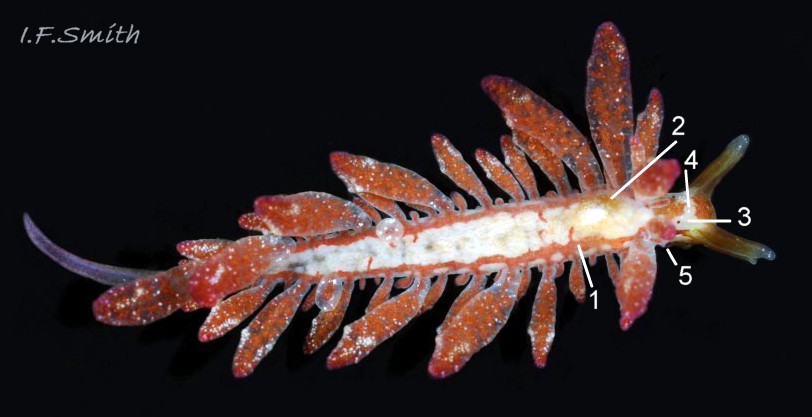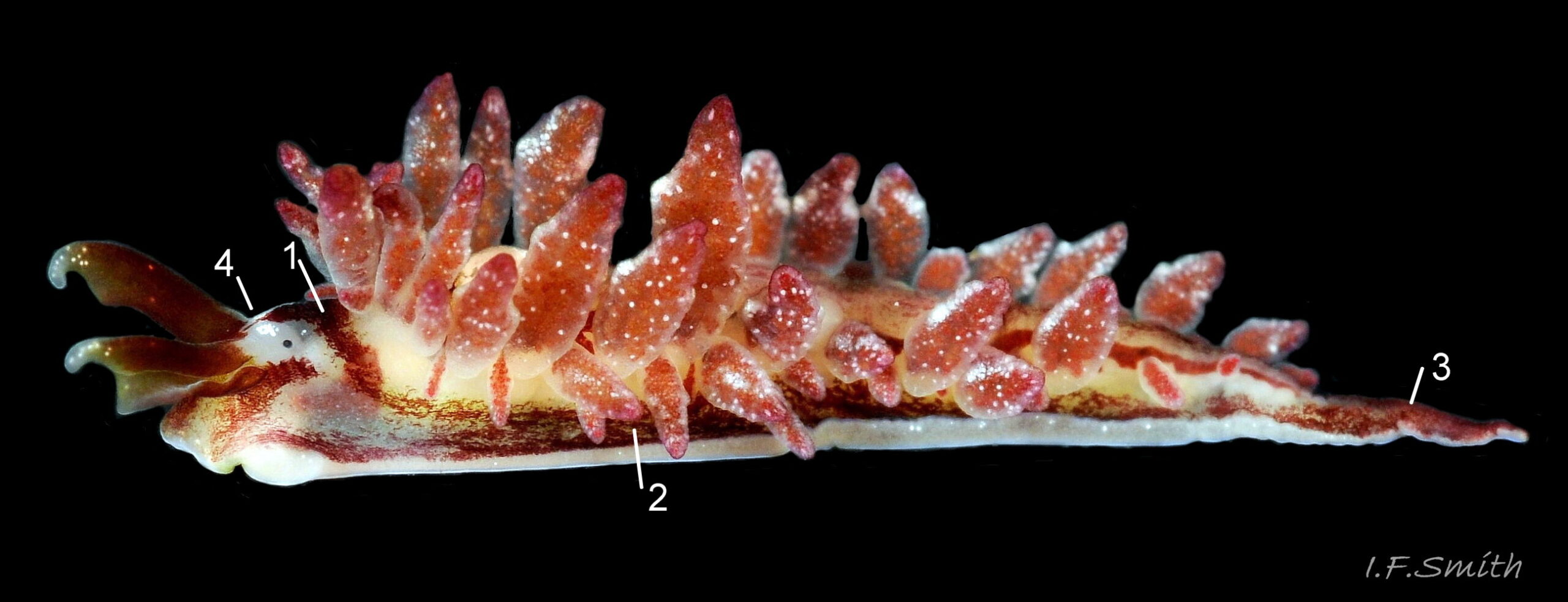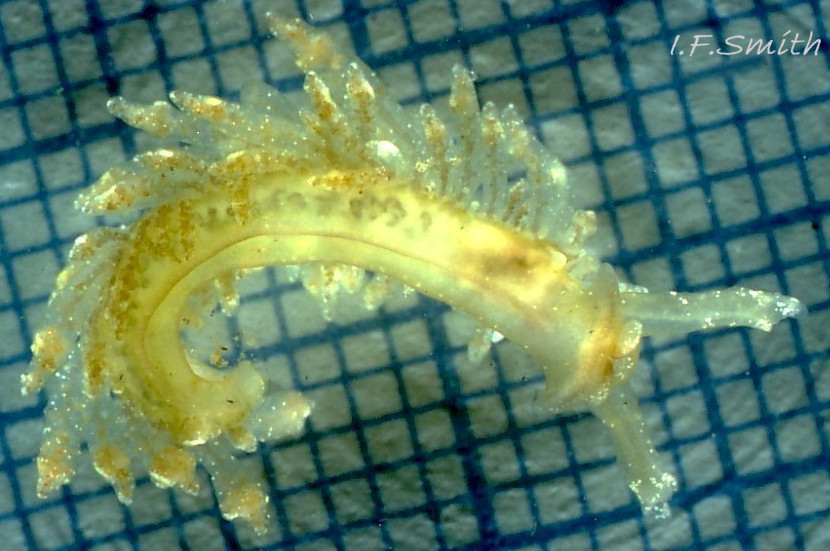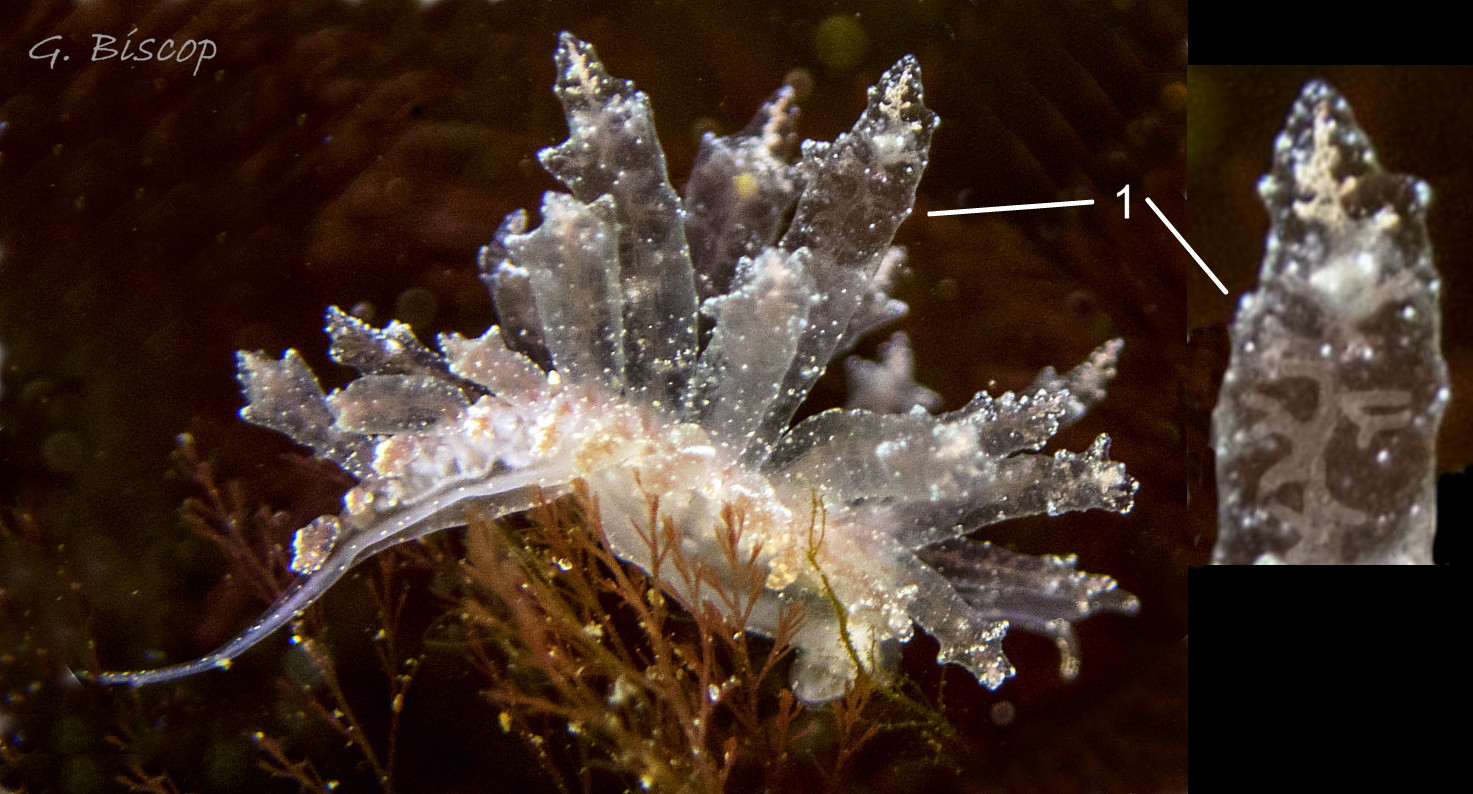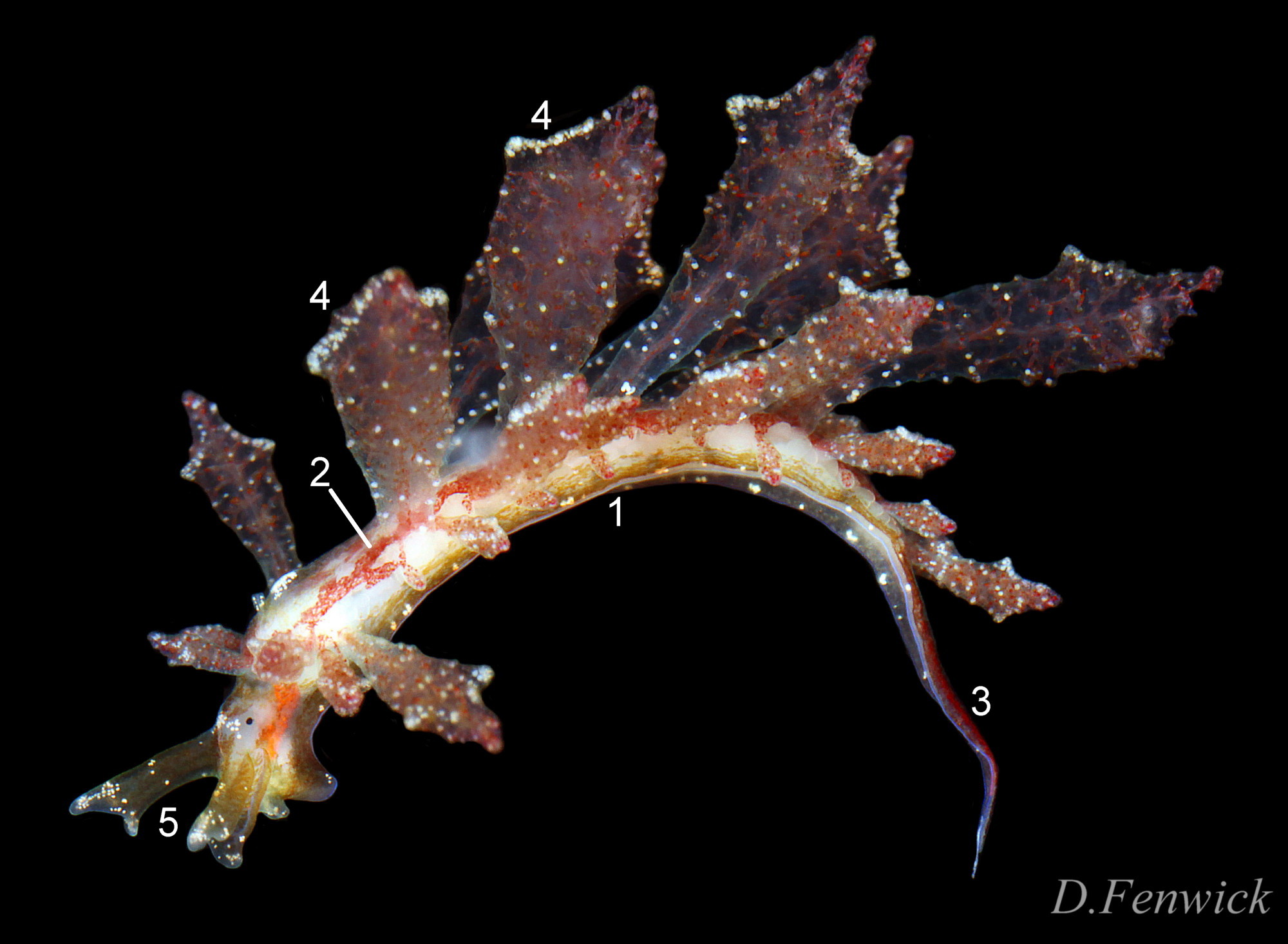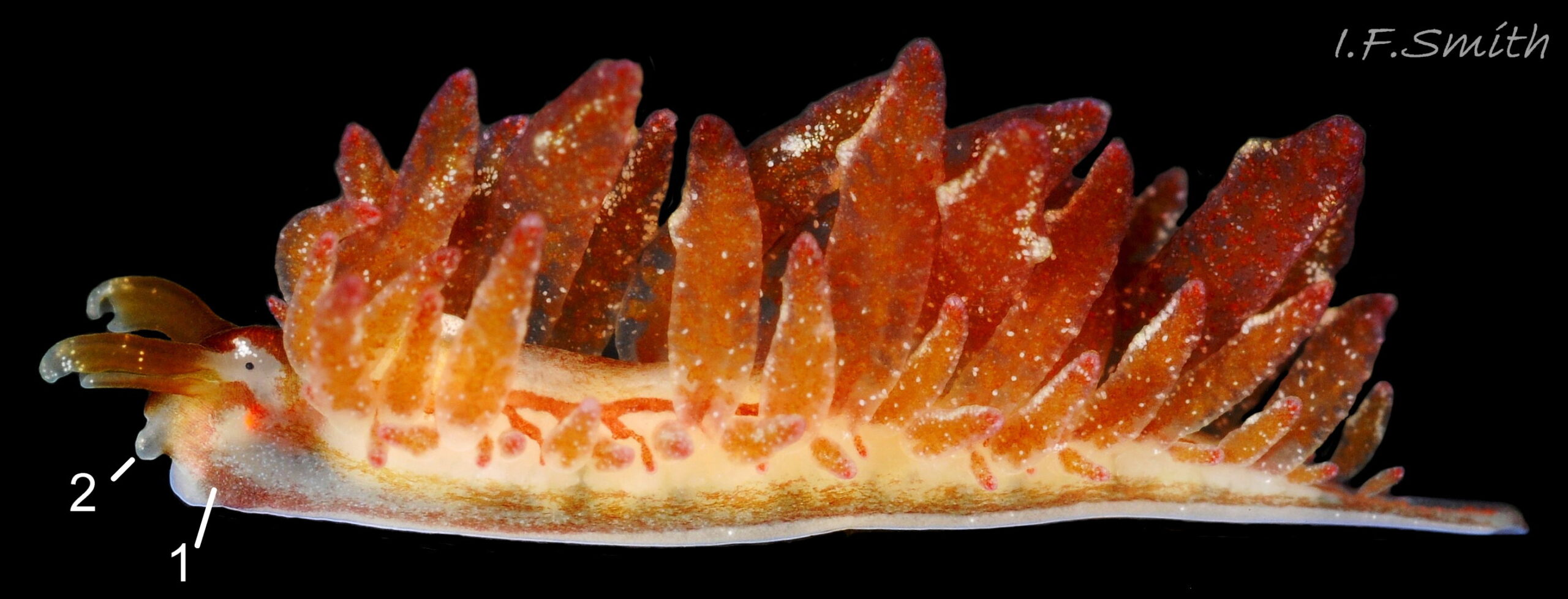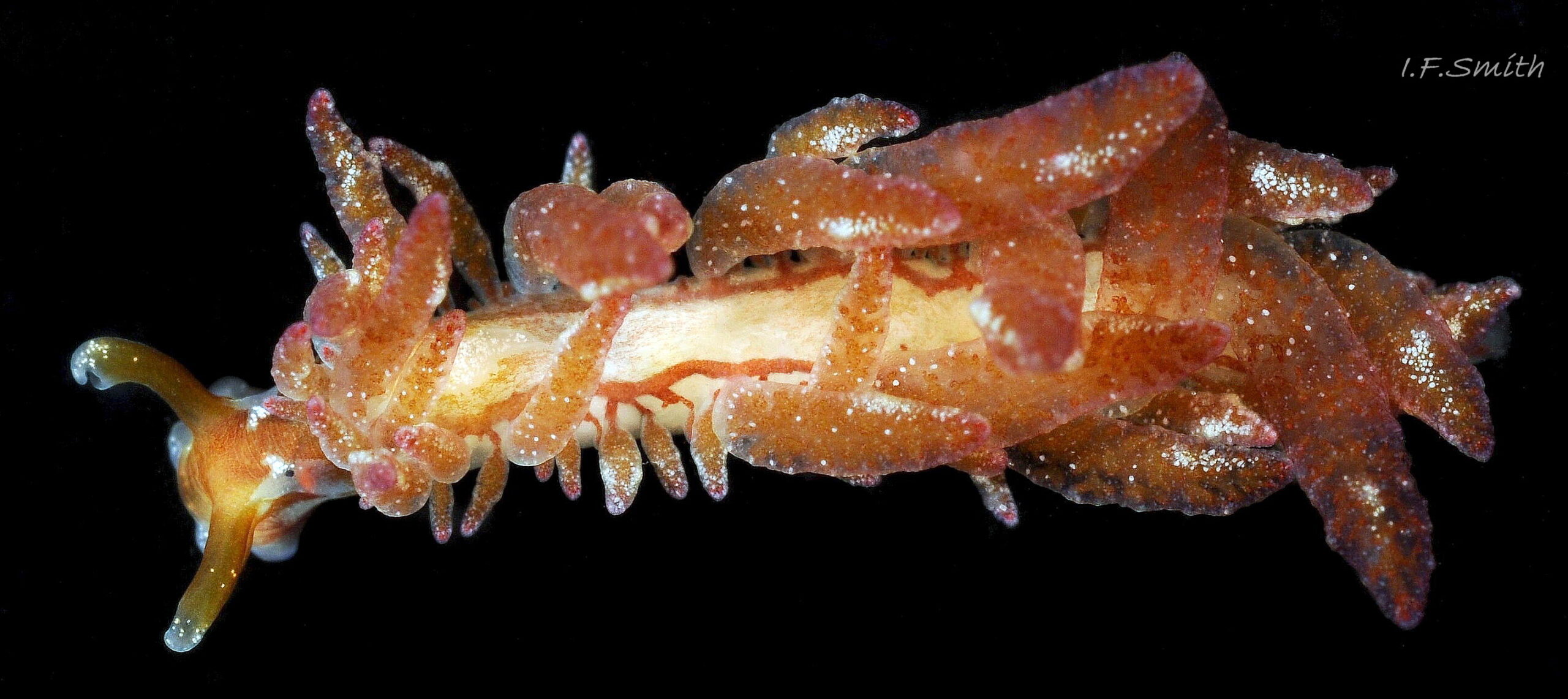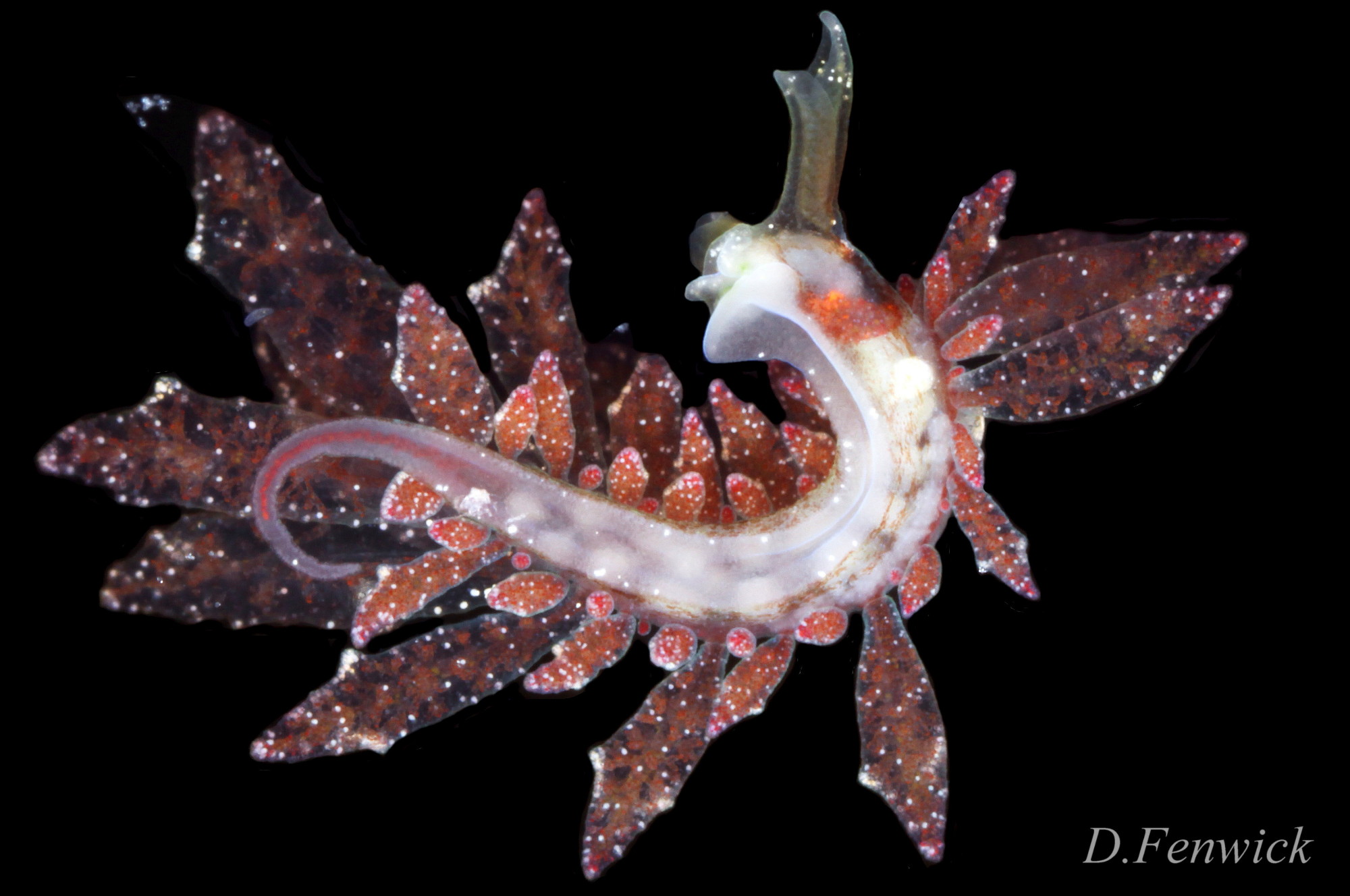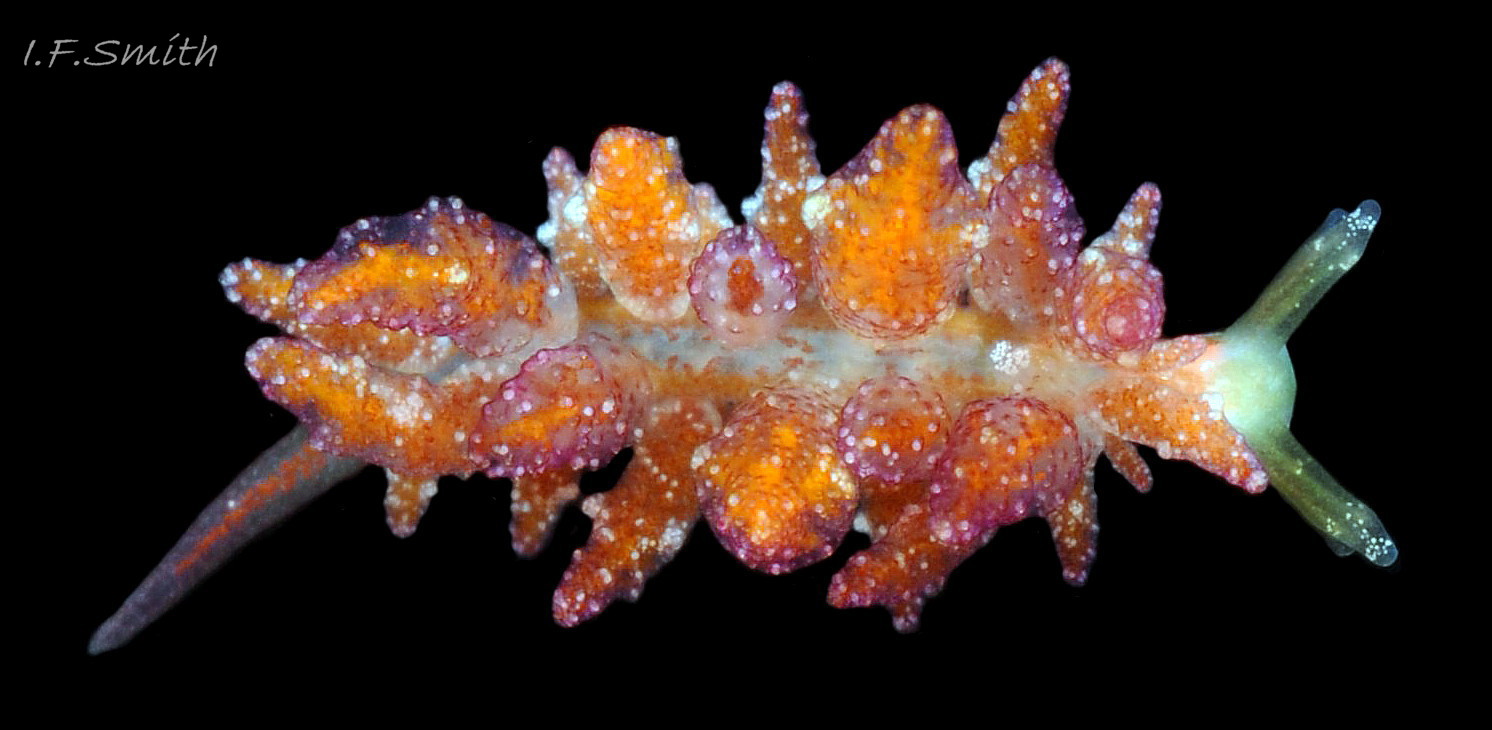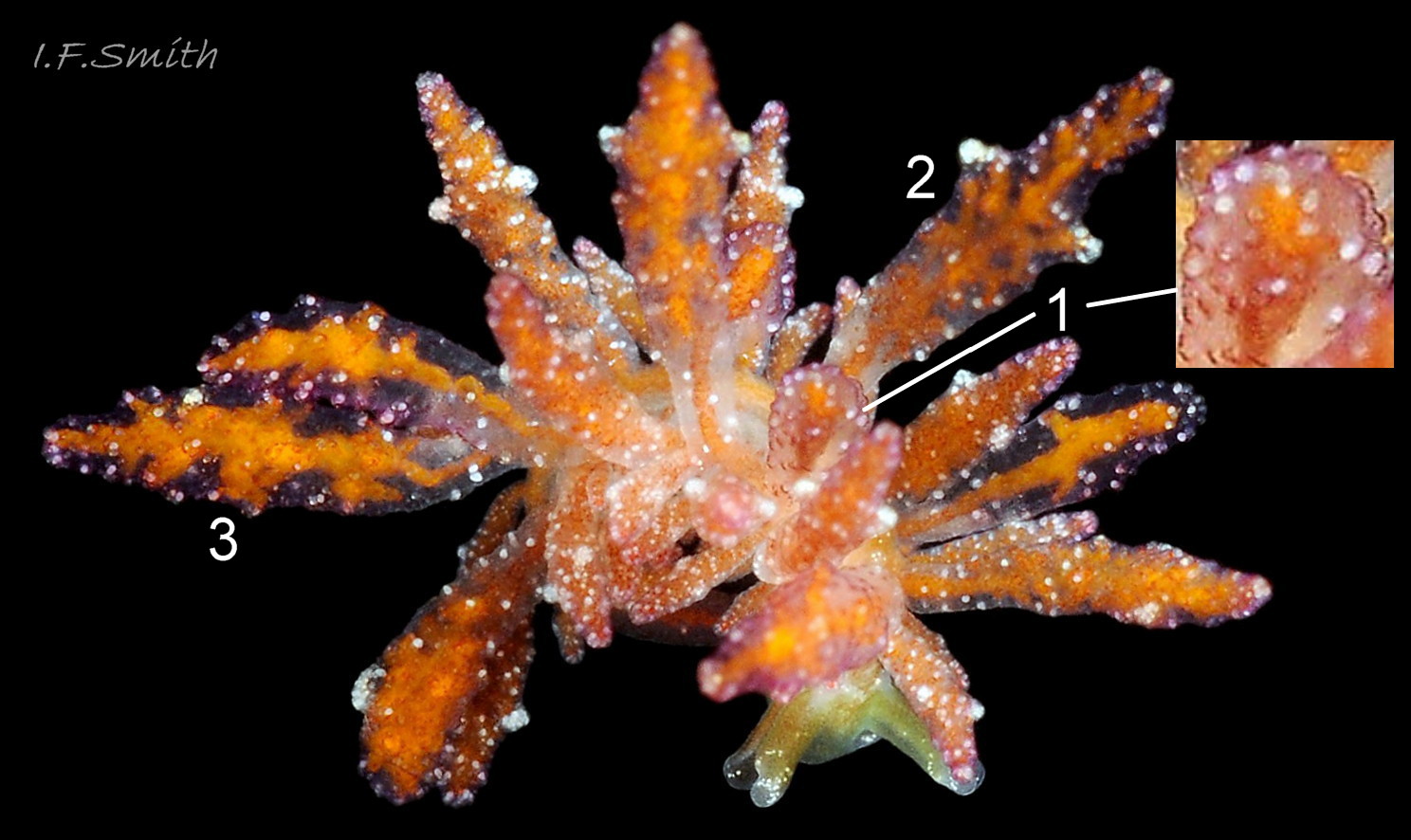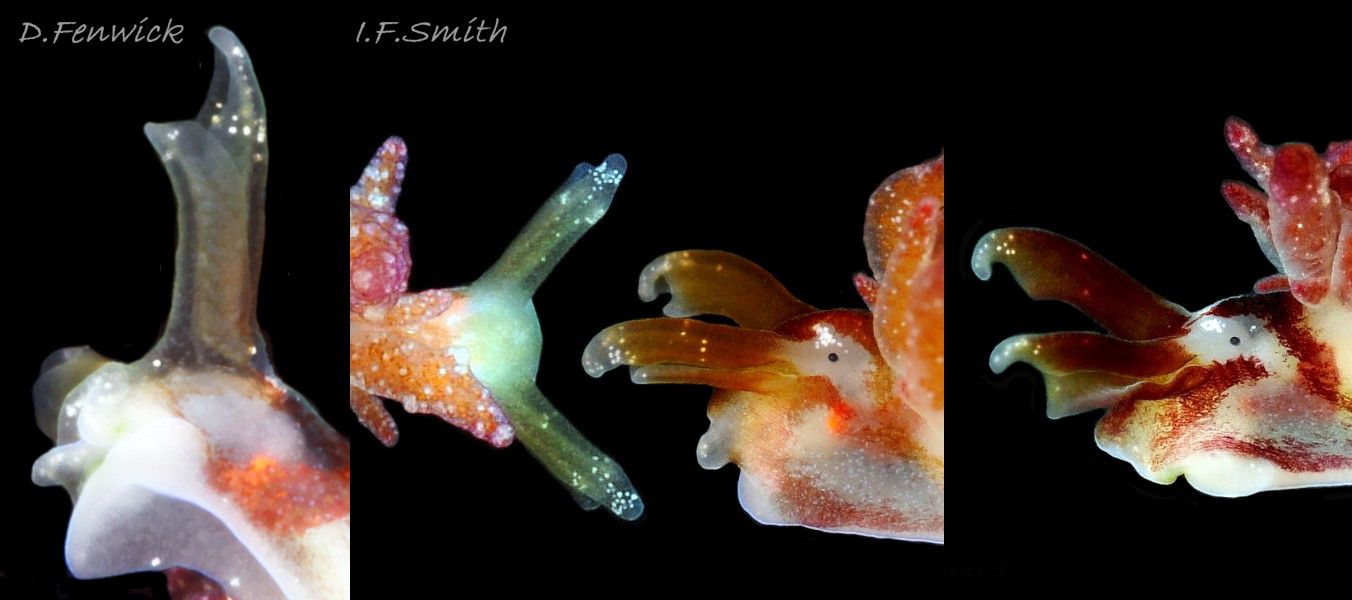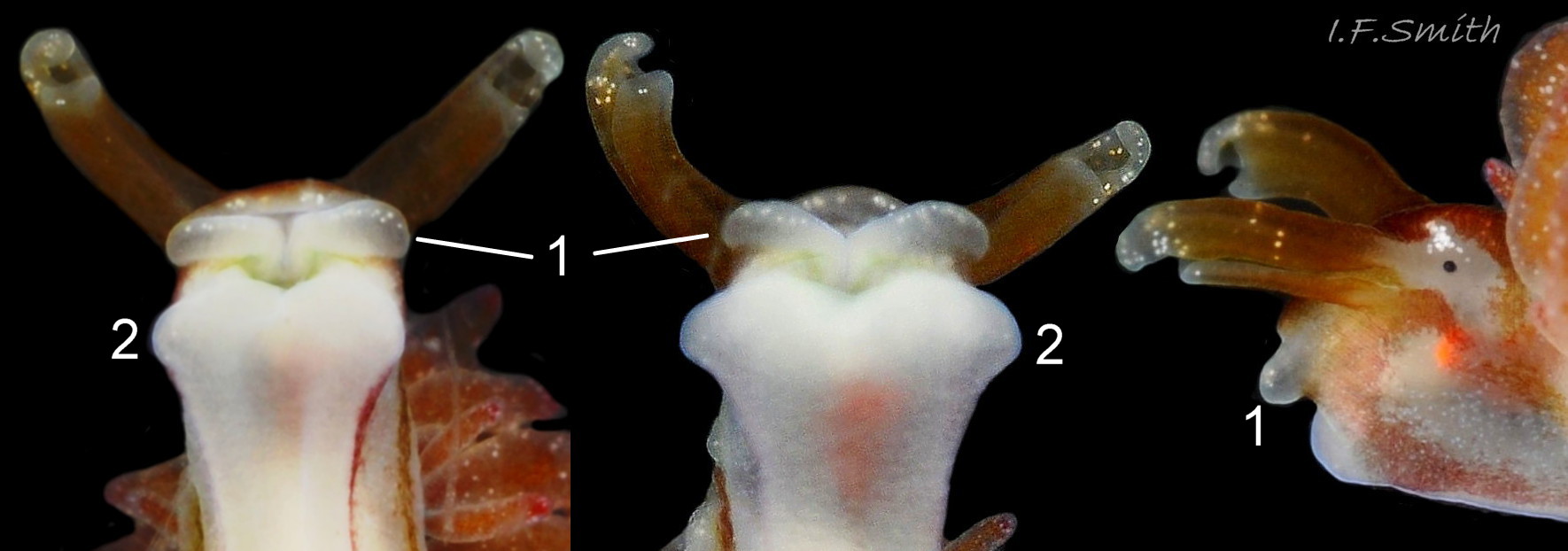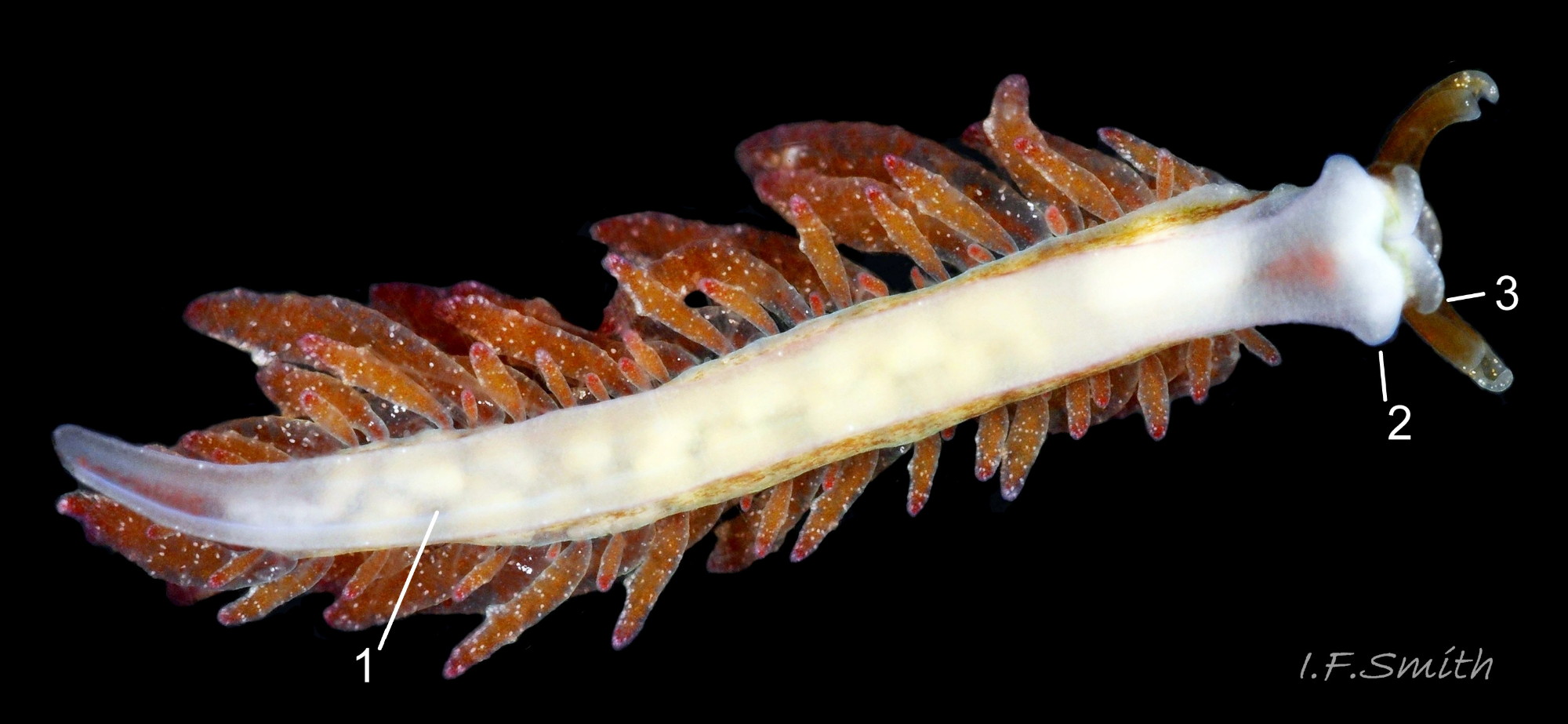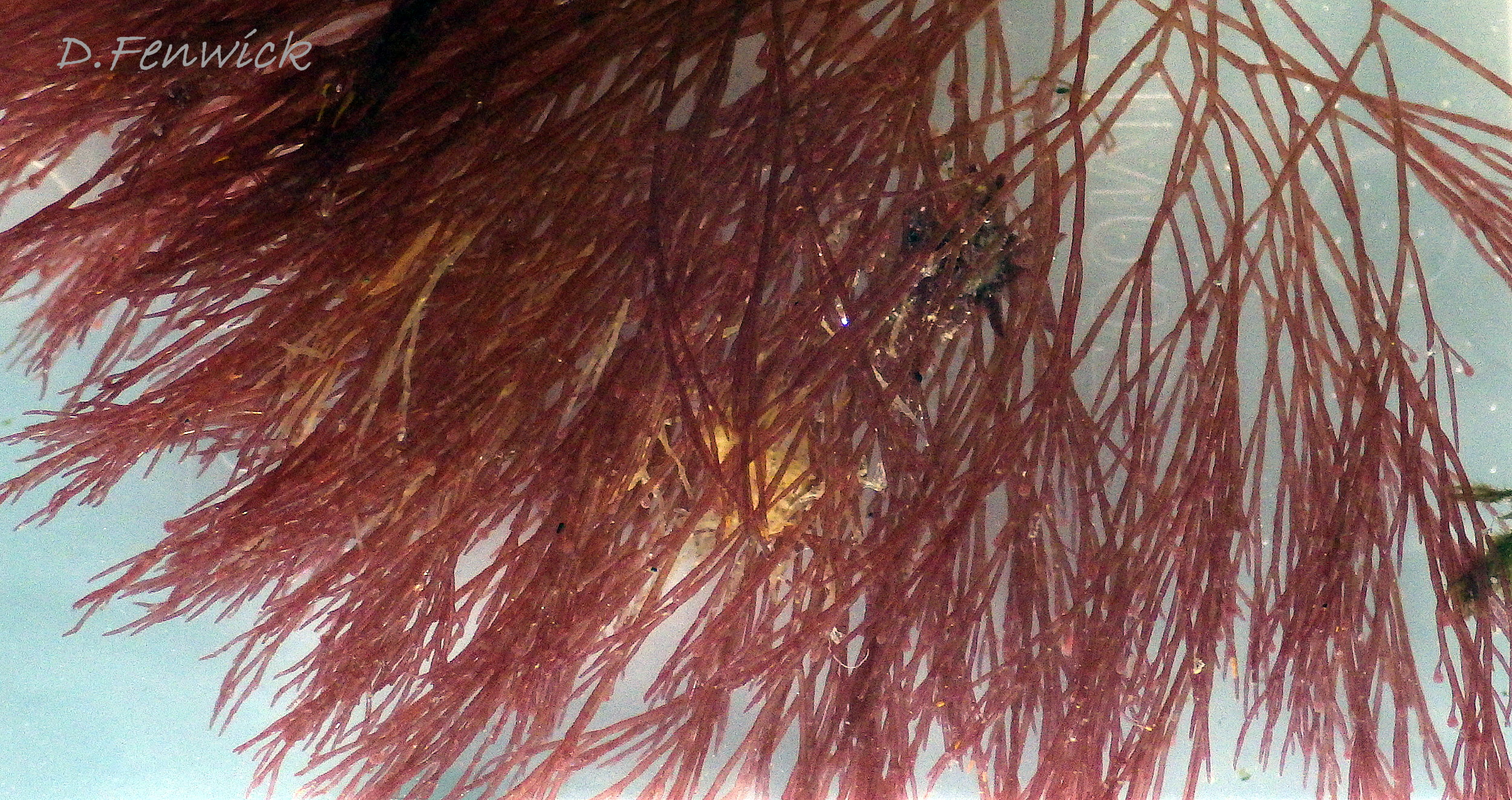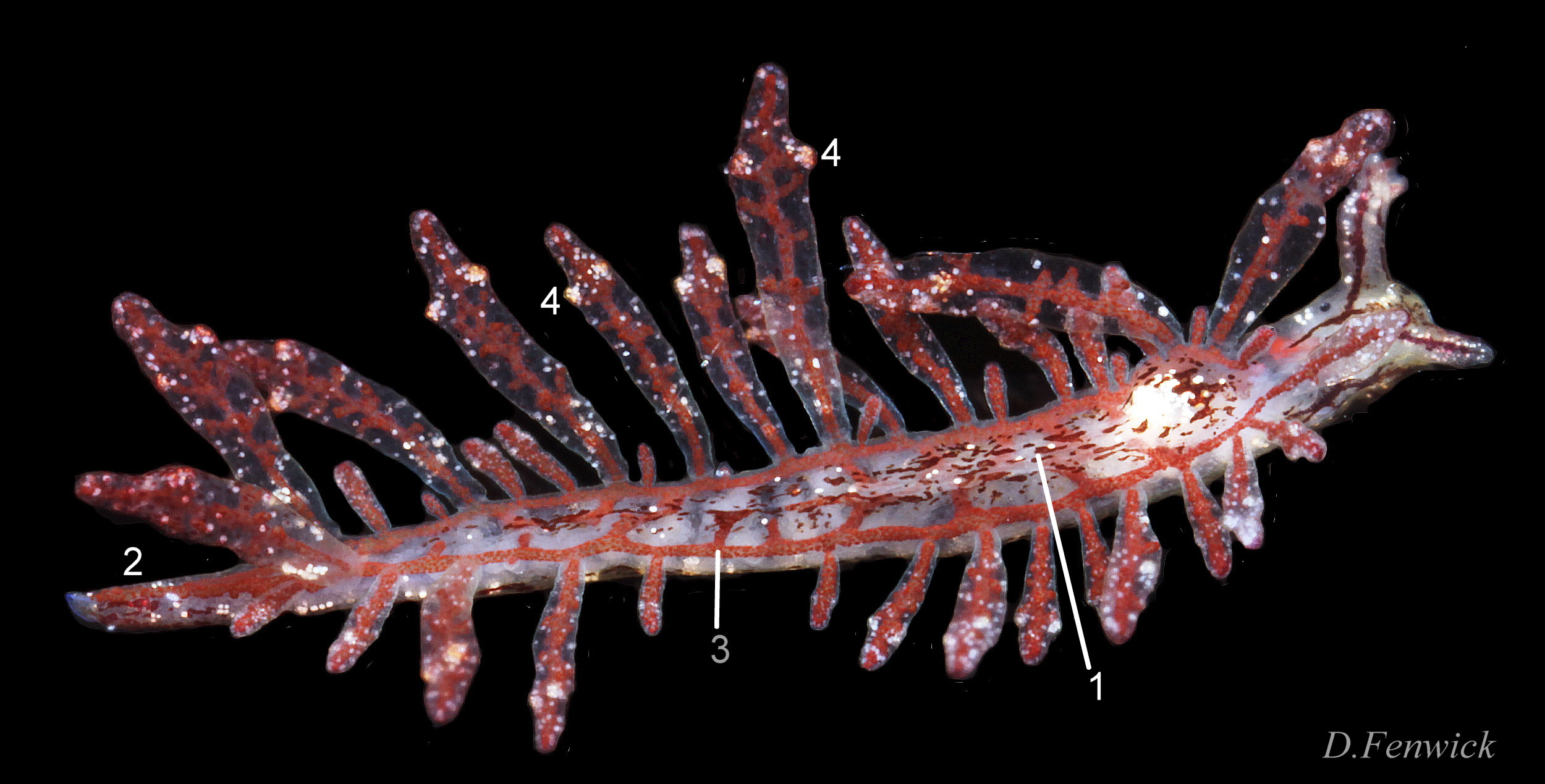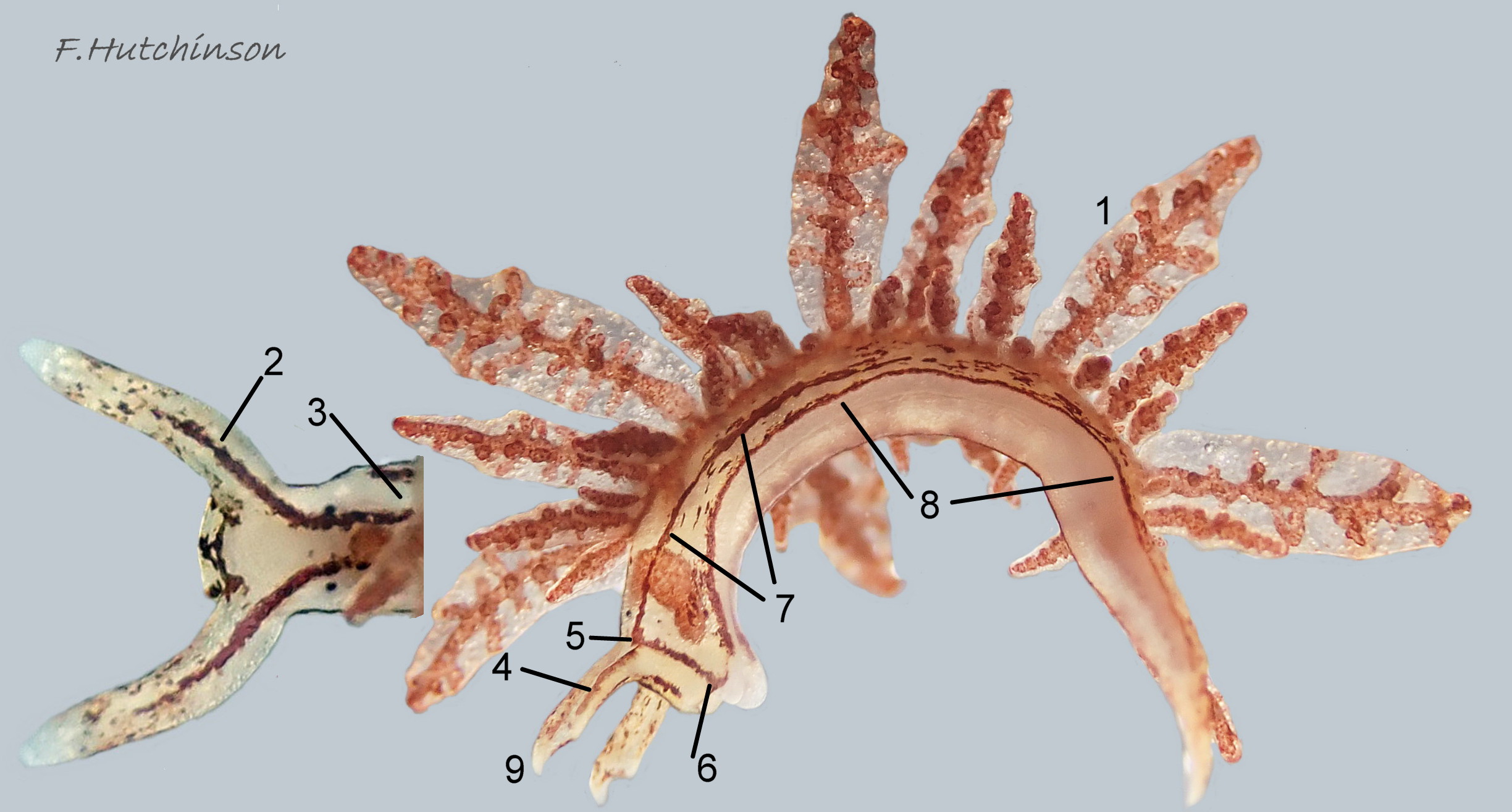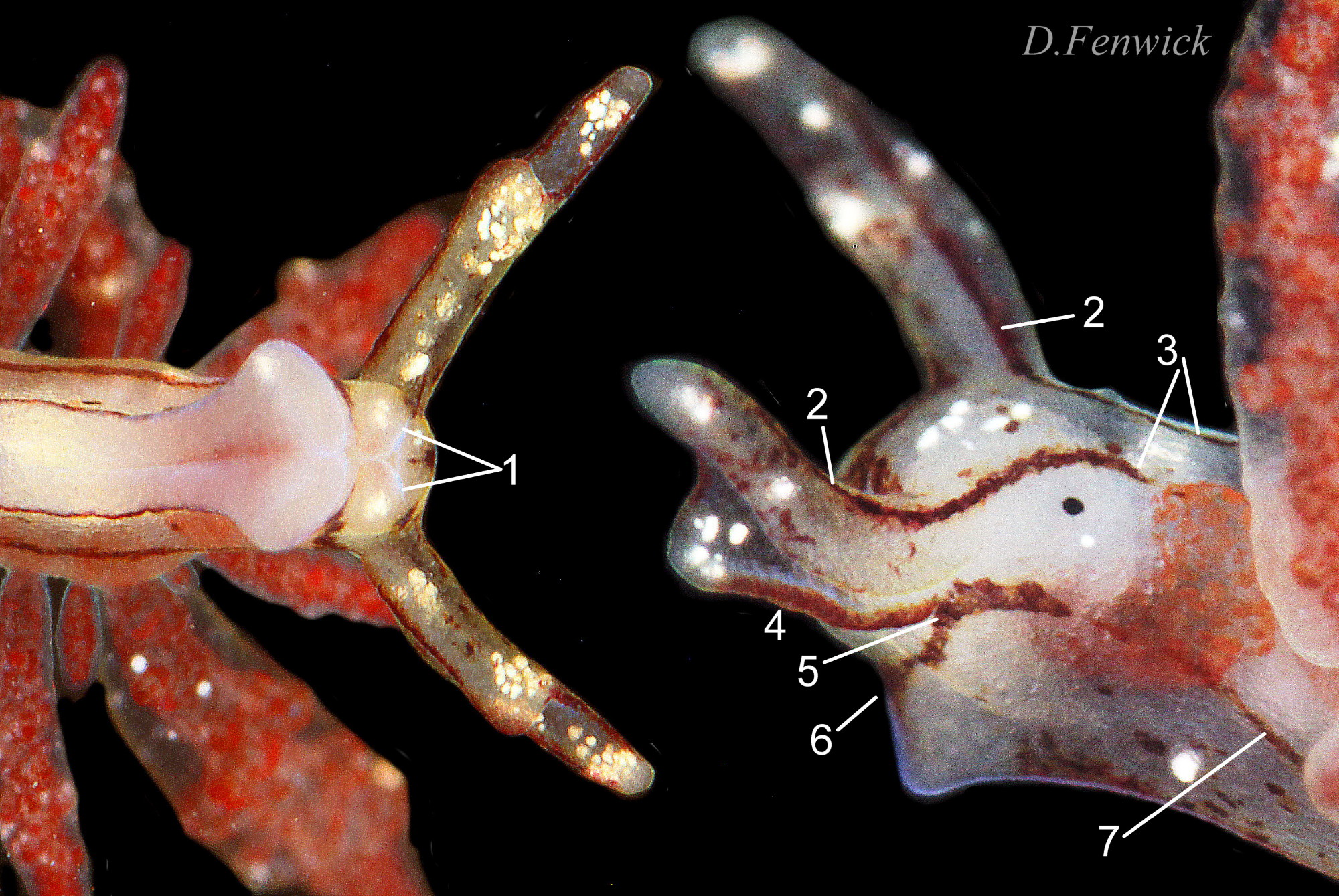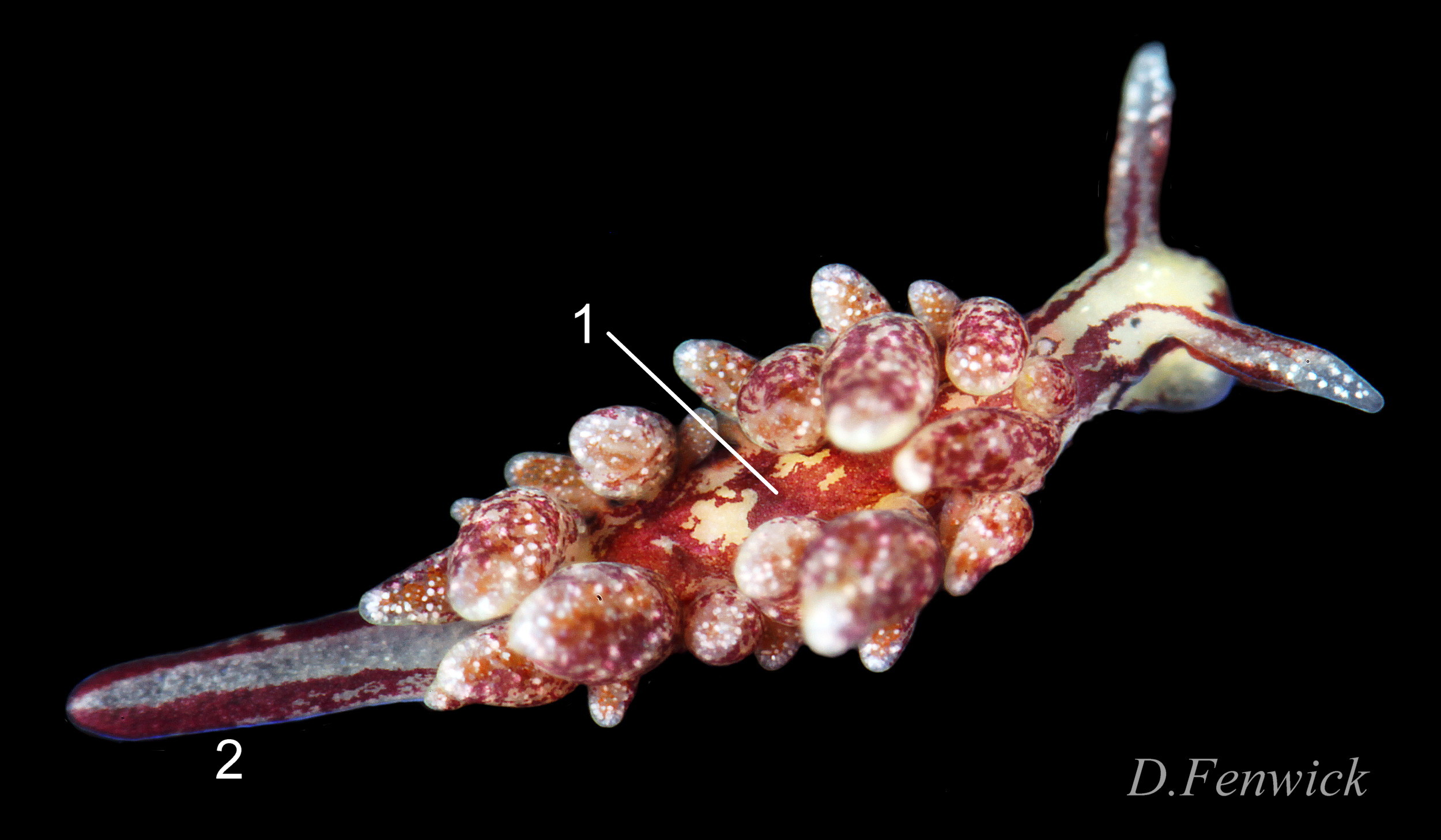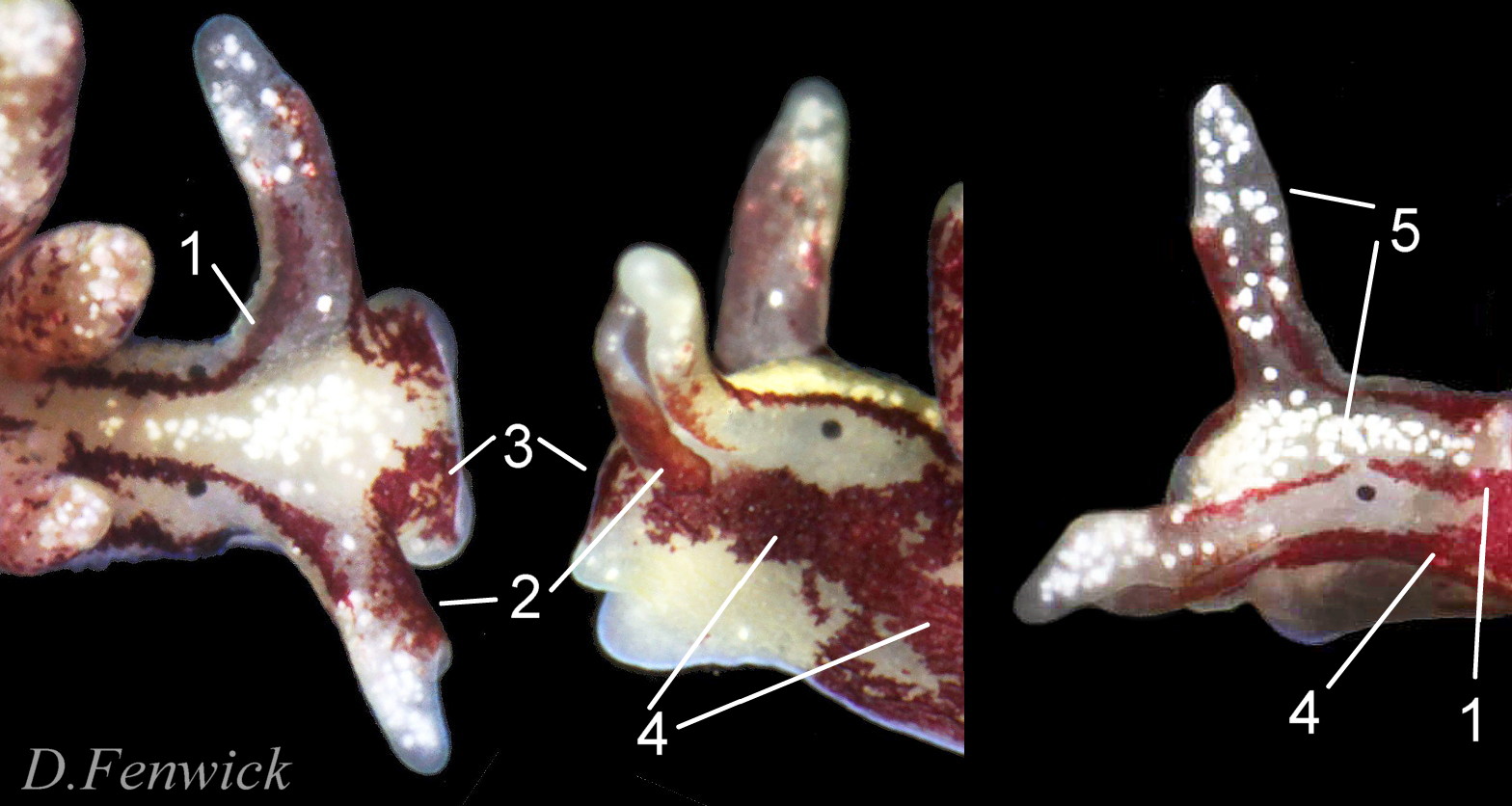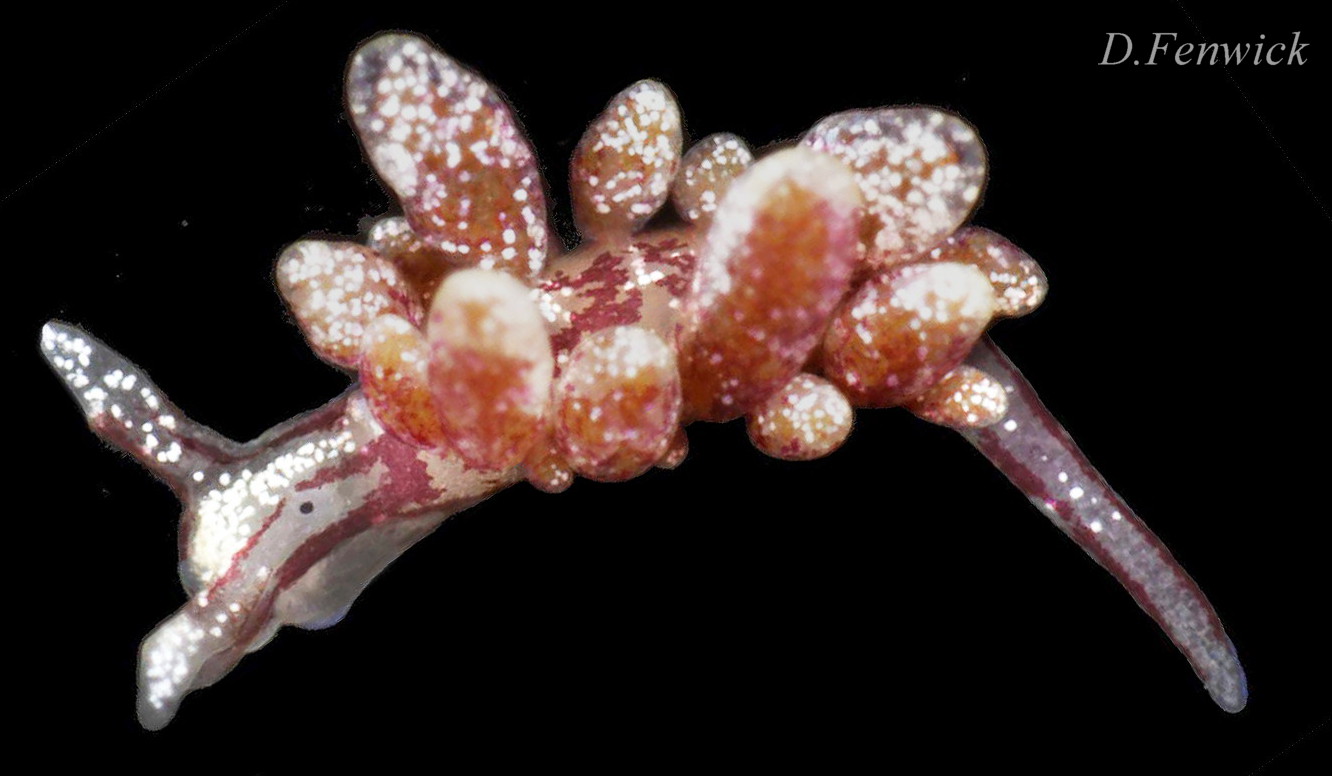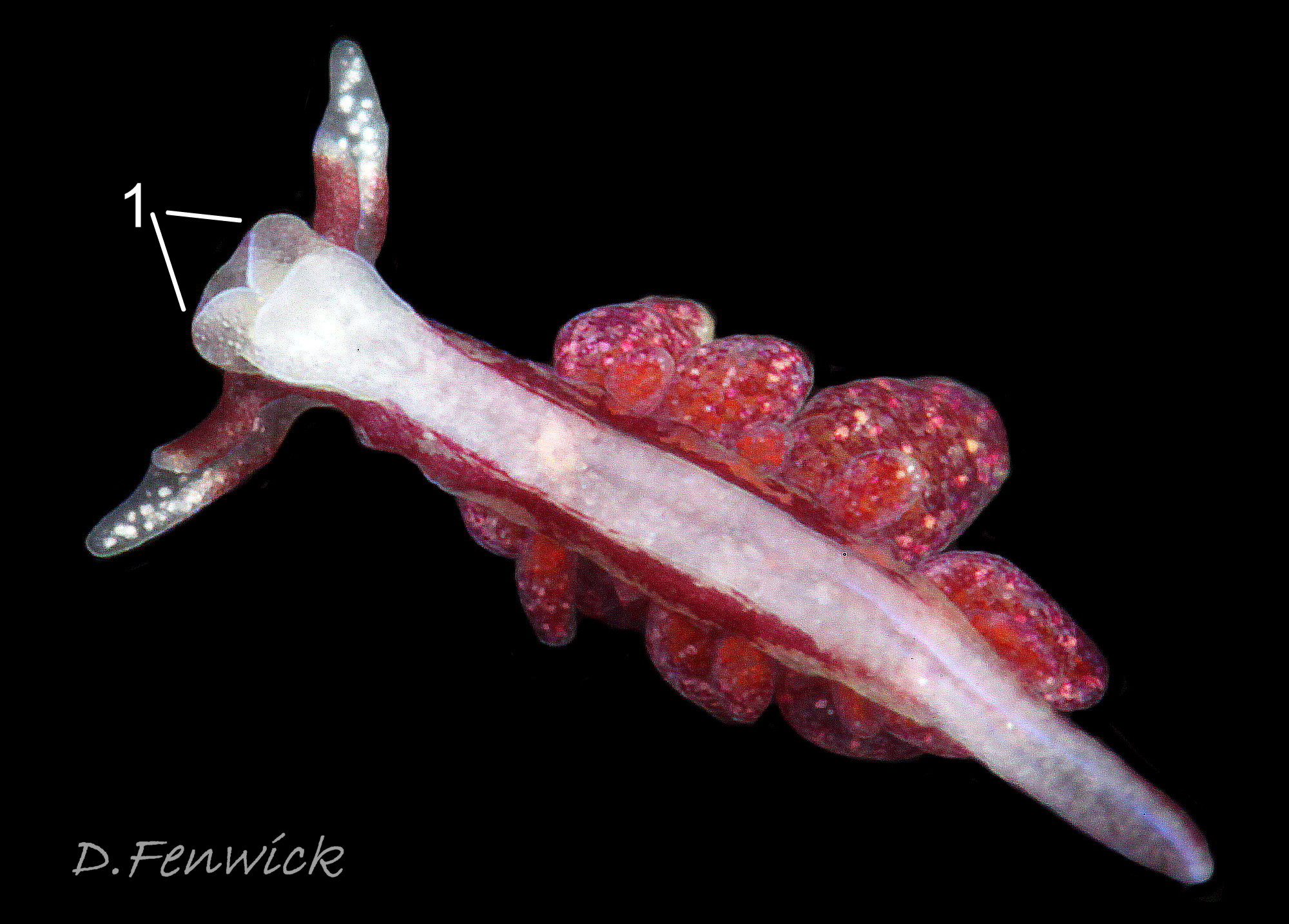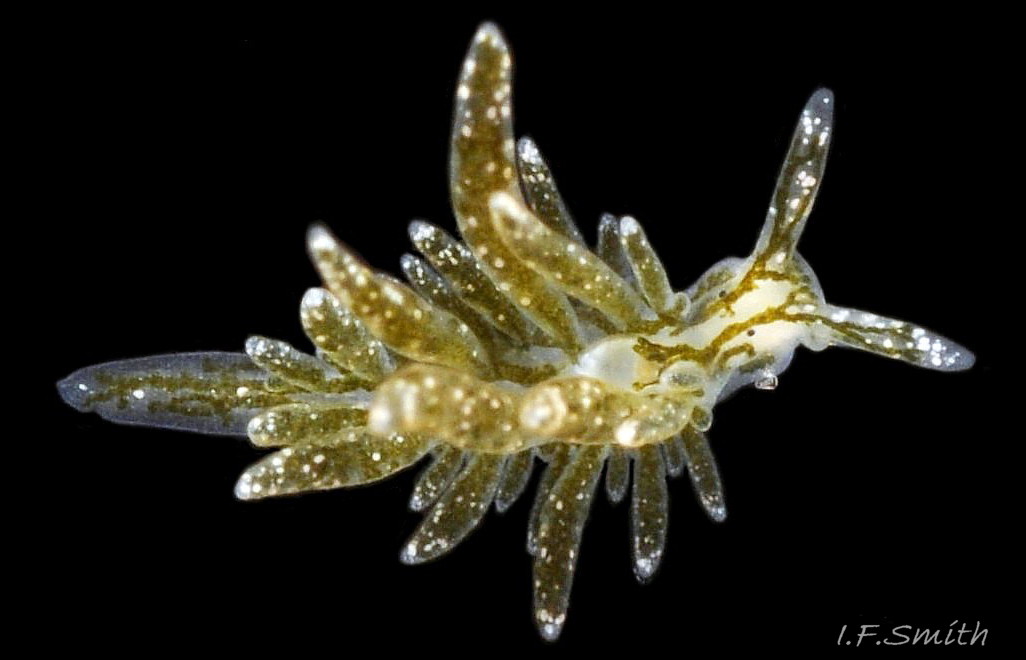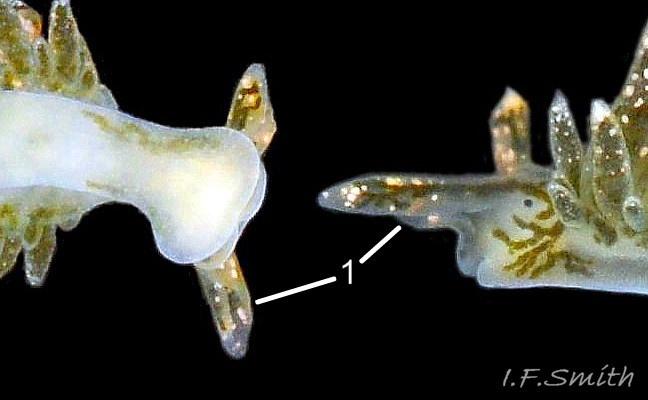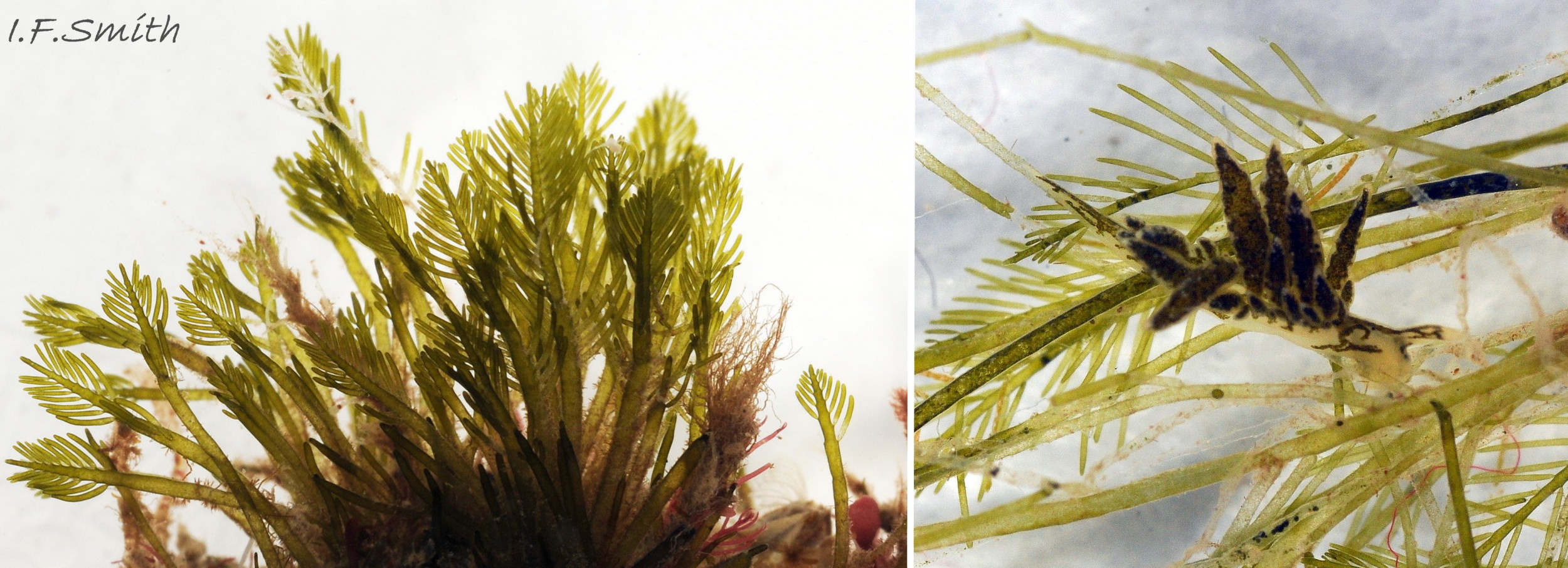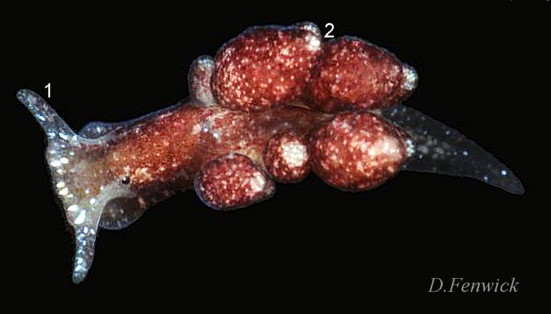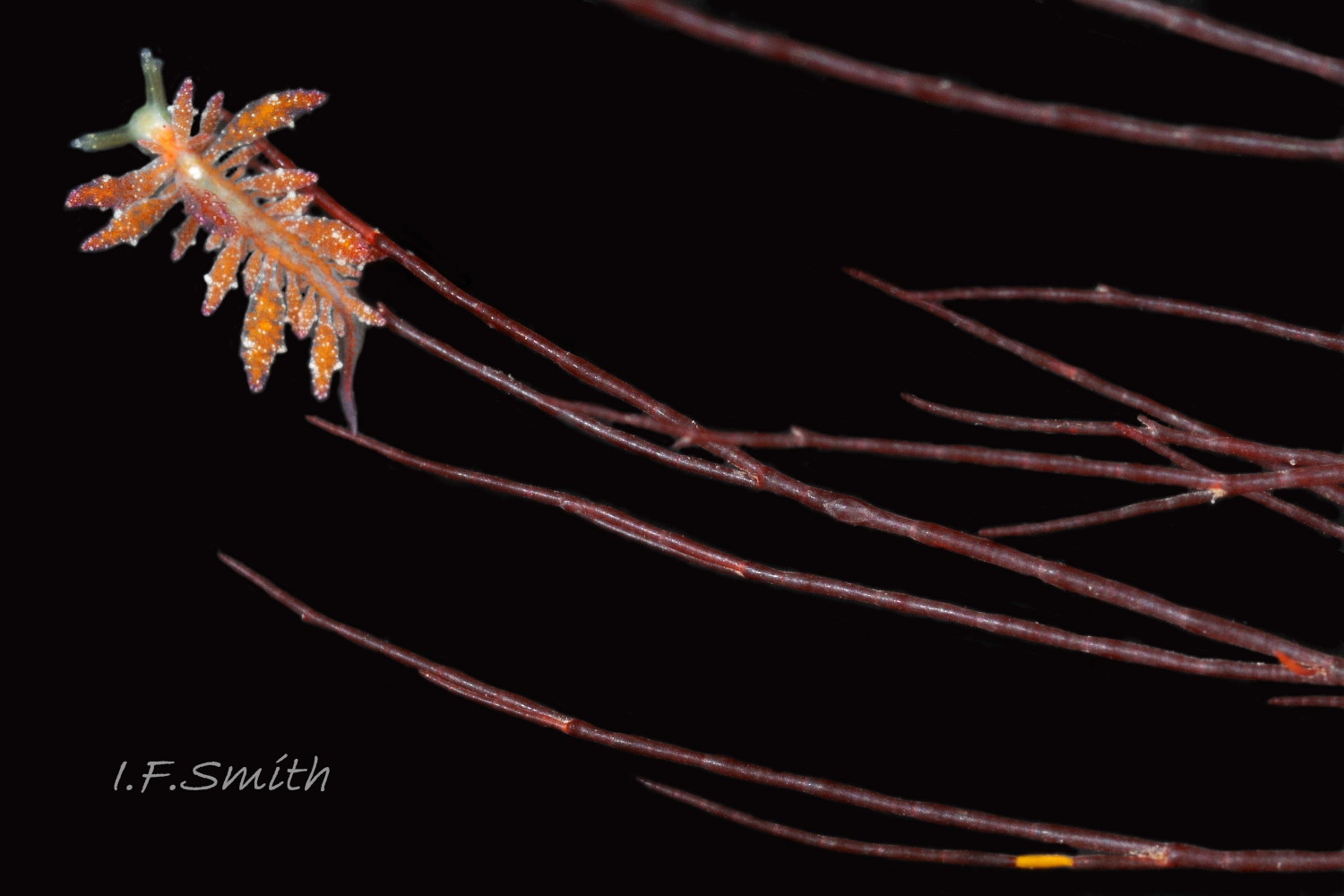Click image to enlarge with full caption. Main text below slider.
Hermaea bifida (Montagu, 1816)
Authors: David Fenwick and Ian F. Smith (text).
PDF available at www.researchgate.net/publication/369996574_Hermaea_bifida…
Synonyms: Doris bifida Montagu, 1816, Hermaea hancockii Trinchese, 1877
Current taxonomy: World Register of Marine Species
www.marinespecies.org/aphia.php?p=taxdetails&id=140092
GLOSSARY BELOW
Description
The long slender body of H. bifida grows up to 20 mm long; its length is about 10X its width at the first cerata 01 Hermaea bifida . The body of fed specimens is translucent white with orange-red, orange-brown to maroon-red marks on the head, along the flanks below the cerata and on the long slender metapodium 02 Hermaea bifida & 06 Hermaea bifida . Apart from some pale brown around the pericardium and occasionally elsewhere, the white notum has no significant red marks on its surface but the digestive gland is visible as a longitudinal red line connecting with the bases of the cerata on either side of the notum 01 Hermaea bifida . There are many small, opaque white spots which usually coalesce into a larger patch on the pericardium 03 Hermaea bifida . If H. bifida is displaced from its red food algae so feeding ceases, its colours fade to yellowish 04 Hermaea bifida and then colourless transparent apart from some opaque white pigment 05 Hermaea bifida . Directed search with magnification is needed to find the plentiful, cryptically red coloured ones on fine red algae. Most undirected observations and images are of displaced starved ones with colour loss. The tubular anal papilla is anterior of the pericardium 03 Hermaea bifida . A genital papilla is below and behind the right eye 01 Hermaea bifida .
There are many large cerata along each side of the body 06 Hermaea bifida . They can be held erect 07 Hermaea bifida , over the body 08 Hermaea bifida or splayed out exposing the notum 01 Hermaea bifida . The cerata are crowded as there is also a series of smaller cerata distally alongside the larger ones 09 Hermaea bifida . They are translucent with variably intense red tinting and many small, transparent tubercles 10 Hermaea bifida & 11 Hermaea bifida which are often difficult to discern in photographs. Scattered, small, opaque white spots on the cerata may coalesce into larger patches distally 06 Hermaea bifida & 08 Hermaea bifida . The digestive gland is often visible within each ceras. Its central axis extends to the ceratal tip as there is no cnidosac. All along length of the axis there are ramified and distally forked branches which nearly reach the ceratal surface 11 Hermaea bifida .
The colour of the digestive gland varies from red when it is well fed on red algae, fading through buff-yellow 04 Hermaea bifida to transparent colourless when not fed 05 Hermaea bifida .
Each rhinophore is an enrolled tube slit open down the distal side. The interior is olive brown, and the exterior is tinted with a variable intensity of translucent red which combines with the inner colour to vary from olive to mahogany red 12 Hermaea bifida & 06 Hermaea bifida . The apical corners of the enrolled tube are produced into two unequal, translucent white points with the posterior point longer and curved forwards. There are usually a few opaque white spots on the rhinophores, especially distally.
Dorsally the head may be reddish in front of, between and behind the rhinophores, but the eyes are always in a translucent white eye patch, often with ‘eye brows’ of opaque white spots 08 Hermaea bifida which sometimes meet as a transverse bar 01 Hermaea bifida , and occasionally the head may be all white 10 Hermaea bifida . Laterally, the head is translucent white, with broad red marks 02 Hermaea bifida which may form a horseshoe shape below the eye 07 Hermaea bifida . The extent and intensity of the red varies and is entirely missing on unfed specimens. Ventrally the head is translucent white and consists of the mouth and distinct lateral oral lobes 13 Hermaea bifida & 07 Hermaea bifida .
The long, tapering, slender foot has a translucent white sole which reveals the spheroidal, white ovotestes 14 Hermaea bifida . It is widest at the anterior which is indented medially and expanded into propodial swellings 13 Hermaea bifida . When fully extended it is exposed far to the posterior of the cerata and its length is about 10 times its width at the first cerata. The dorsal rim of the foot is usually white.
Key identification features
Hermaea bifida
H. bifida sensu lato varies much and has had some species segregated from it. The following may include others yet to be discovered.
1) Maximum length 20 mm. Long slender body; length about 10X width at first cerata 01 Hermaea bifida .
2) Fed specimens translucent white with orange-red, orange-brown to maroon-red areas on head, along flanks and on metapodium 02 Hermaea bifida & 06 Hermaea bifida . No significant red surface marks on notum but digestive gland is visible as longitudinal red line on either side 01 Hermaea bifida . Unfed specimens colourless 05 Hermaea bifida .
3) Rhinophore a slit, enrolled tube; interior olive brown; exterior olive to mahogany; two white apical points, longer one often hooked 12 Hermaea bifida .
4) Cerata appear crowded as distal series of small cerata next to the large cerata 09 Hermaea bifida .
5) Small colourless tubercles on surface of cerata (often difficult to discern in photographs) 10 Hermaea bifida & 11 Hermaea bifida .
6) Digestive gland in cerata has ramified and distally forked branches which nearly reach the ceratal surface 11 Hermaea bifida .
7) Mouth has distinct oral lobes protruding laterally 13 Hermaea bifida & 07 Hermaea bifida .
8) Feeds on red algae such as Griffithsia, Delessaria, Heterosiphonia and Halurus flosculosus15 Hermaea bifida .
9) All around British Isles, Atlantic France, southern Scandinavia and possibly western Mediterranean.
Similar species
Hermaea cantabra Caballer & Ortea, 2015.
1) Maximum length 9 mm.
2) Translucent white, with many small red to brown spots and streaks on the notum16 Hermaea bifida COMPARE Hermaea cantabra , flanks and metapodium. Digestive gland is visible as longitudinal red line with many T-shaped branches on either side of notum. Diagnostic thin red lines run a) down the posterior of each rhinophore and between the eyes to the first ceras 17 Hermaea bifida COMPARE Hermaea cantabra , b) down the distal edge of the rhinophore-slit 18 Hermaea bifida COMPARE Hermaea cantabra , bifurcating at the rhinophore base to send a short branch to the anterior of the head and a lateral line half the length of the body and c) along the dorsal edge of the foot for its full length. [Some H. bifida have a similar pattern of broad bands 07 Hermaea bifida .]
3) Rhinophore a slit, enrolled tube; interior and exterior translucent white freckled with opaque white spots and red freckles 18 Hermaea bifida COMPARE Hermaea cantabra ; two apical points, longer one slightly curved 17 Hermaea bifida COMPARE Hermaea cantabra .
4) Elongate cerata are spaced apart in a single series of large and small ones on either side of the notum 16 Hermaea bifida COMPARE Hermaea cantabra & 17 Hermaea bifida COMPARE Hermaea cantabra .
5) Smooth cerata often have bulges where branches of the digestive gland approach the surface, especially white ones at about 25% of length from apex, but there are no small tubercles 16 Hermaea bifida COMPARE Hermaea cantabra . (Those on H. bifida may be difficult to discern in photographs.)
6) Branches of digestive gland in cerata are not ramified and forked.
fig. 17 17 Hermaea bifida COMPARE Hermaea cantabra .
7) Mouth has large rounded lips which do not extend as lateral lobes 18 Hermaea bifida COMPARE Hermaea cantabra .
8) In Cornwall, England, it probably feeds on Halurus equisetifolius (Lightfoot) Kützing, 1843 and possibly on the introduced alien Antithamnionella ternifolia (Hooker f. & Harvey) Lyle, 1922 19 Hermaea bifida COMPARE Hermaea cantabra (Fenwick 2023b). Often with H. paucicirra.
9) Currently (2023) there are records from north-west Spain and Atlantic France to south-west England and the Netherlands.
Hermaea paucicirra Pruvot-Fol, 1953.
1) Maximum length about 4 mm. Body tapers rapidly from broad anterior to narrow posterior. Much less slender than H. bifida; length about 5X width at first cerata.
2) Translucent white body with extensive dark maroon blotches which conceal the digestive gland in the notum20 Hermaea bifida COMPARE Hermaea paucicirra . Maroon band runs down the posterior of each rhinophore and between the eyes to join maroon blotch on notum. Broad maroon band runs down the distal edge of the rhinophore-slit, bifurcating at the rhinophore base to send a short broad branch to the anterior of the head 21 Hermaea bifida COMPARE Hermaea paucicirra and a broad, uneven, sometimes discontinuous, dark maroon, lateral band22 Hermaea bifida COMPARE Hermaea paucicirrato the metapodium where the right and left bands remain separated by a dorsal strip of translucent white with some opaque white spots20 Hermaea bifida COMPARE Hermaea paucicirra . No maroon line along edge of foot but lateral band may extend to the edge at a few points. Small opaque white spots are scattered over the body and are concentrated densely on the rhinophores and dorsum of the head 21 Hermaea bifida COMPARE Hermaea paucicirra .
3) Rhinophore a slit, enrolled tube which tapers to a single point. Interior and exterior translucent white with two maroon bands and many small, opaque white spots 21 Hermaea bifida COMPARE Hermaea paucicirra .
4) Single series of 5 to 7 large ovoid cerata and some smaller ones along each side of notum 23 Hermaea bifida COMPARE Hermaea paucicirra .
5) Ovoid, smooth cerata with no small tubercles. Covered by red pigment and scattered opaque white spots which are concentrated distally 22 Hermaea bifida COMPARE Hermaea paucicirra .
6) Digestive gland in cerata is bunch-shaped (Caballer & Ortea, 2015), but concealed by surface pigment.
7) Mouth has large rounded lips which do not extend as lateral lobes 24 Hermaea bifida COMPARE Hermaea paucicirra .
8) Probably feeds on fine red algae. Found on calcareous Corallina in Cornwall (Fenwick, 2023c) but unsuitable for suctorial feeding. Often with H. cantabra.
9) Known from the Gulf of Cadiz, Spain and Cornwall and Devon, England. Probably at intervening places, but overlooked because of its small size and cryptic colouring when on red algae. Only likely to be found by careful searching of fine red algae under magnification.
Placida dendritica (Alder & Hancock, 1843).
1) Maximum length about 11 mm. Length about 8X width when fully extended.
2) Body translucent whitish with dendritic green markings 25 Hermaea bifida COMPARE Placida dendritica fades to yellowish brown when unfed.
3) Rhinophore enrolled, widely slit open down anterior, with dendritic green markings 26 Hermaea bifida COMPARE Placida dendritica .
4) Green digestive glands visible in cerata 25 Hermaea bifida COMPARE Placida dendritica .
8) Feeds in Europe on green Bryopsis plumosa (Hudson) C.Agardh, 1823 27 Hermaea bifida COMPARE Placida dendritica and Codium species. Perhaps also on Derbesia species.
9) Northern Norway to Mediterranean. All round British Isles. It, or similar looking species, found in North America, Asia and Australia.
Calliopaea bellula d’Orbigny, 1837
These features are of its occasional red form 28 Hermaea bifida COMPARE Calliopaea bellula .
1) Maximum length 10 mm. Length about 3X width when fully extended.
2) Body occasionally dark reddish brown.
3) Rhinophore not enrolled, translucent white with opaque white marks.
4) Digestive gland not visible in body.
5) Ovoid, smooth cerata with no small tubercles. Covered by red pigment and scattered opaque white spots which are concentrated distally.
6) Digestive gland not visible in cerata.
9) Occurs from Norway to the Mediterranean.
Habits and ecology
Unlike nudibranchs, which feed on invertebrates, H. bifida, like its fellow sacoglossans, feeds on algae and has no cnidosacs in its cerata. It lives on rocky substrate and hard surfaces such as floating pontoons at ELWST and in the shallow sublittoral where there is enough light for the red algae which it feeds on, including Griffithsia, Delessaria, Heterosiphonia and Halurus flosculosus15 Hermaea bifida .
It is very well camouflaged on red weed 29 Hermaea bifida . Some recorders report that it has a distinctive smell, variously described as like a Geranium plant or Hydrogen sulphide, which might discourage predators.
It is a simultaneous hermaphrodite. Its small spawn mass contains up to 550 ova with diameter 0.005mm; the smallest recorded ova for a British sea slug. Spawn is reported in Britain in July, September and October. It hatches into veliger larvae which drift as plankton before transforming into adults.
Distribution and status
H. bifida and its congeners are very under recorded because the perfect match with fine red algae of the slender shape and the colour of fed specimens makes them virtually invisible unless they are displaced from the algae, when they lose colour and become transparent white showing the thread-like, emaciated digestive gland 05 Hermaea bifida . Of the 42 images in GBIF gallery www.gbif.org/occurrence/gallery?taxon_key=2298938 (accessed 2 April 2023) about 80% are such ‘white ghosts’ which makes differentiation of H. bifida from its congeners very problematic, and even more so in the Mediterranean where there are more Hermaea species. There are scattered records of it from all around the British Isles species.nbnatlas.org/species/NHMSYS0021316682 , Atlantic France 30 Hermaea bifida and southern Scandinavia.
Iberian and Mediterranean records of H. bifida are uncertain; and may be misidentifications of other species such as in Trigo et al. (2018) which illustrates the H. bifida page with an image of H. cantabra showing its diagnostic lines on the head and T-shaped branches on the digestive gland lines in the notum. In 35 years of fieldwork in the Bay of Biscay only H. cantabra and H. paucicirra, but no H. bifida sensu stricto, were found by Caballer and Ortea (2015) who call into question H. bifida recorded in Iberia and the Mediterranean. The little known Hermaea boucheti first described from the Gulf of Cadiz (Cervera et al., 1988) has ramified and distally forked branches which might lead colourless specimens to be misidentified as H. bifida in Iberia and the Mediterranean.
To find coloured fed specimens, collect a bacon box of fine red weed sublittorally, littorally at ELWST or from the sides of floating pontoons and examine one strand at a time in good light under magnification, if possible with a binocular microscope at about 8X.
Acknowledgements
For use of images I thank Glenn Biscop, Pierre Corbrion, David Fenwick and Finley Hutchinson.
References and links
Alder, J. & Hancock, A. 1845-1855. A monograph of the British nudibranchiate mollusca. Ray Society, London. [Hermaea bifida Family 3 Plate 39].
www.biodiversitylibrary.org/item/131598#page/462/mode/1up
Caballer, M. & Ortea, J. 2015. New data on the genus Hermaea (Mollusca: Sacoglossa) in Europe, with the description of a new species from Spain. Rev. Acad. Canar. Cienc., 27: 125-136. www.researchgate.net/publication/287206056_New_data_on_th…
Cervera, J.L., Garcia-Gomez, J.C. & Ortea, J.A. 1988. Una nueva especie del genero hermaea (Gastropoda: Opisthobranchia: Sacoglossa) y redescripción de dos raros sacoglosos de la malacofauna Europea. Iberus. 8(2): 215-224. www.researchgate.net/publication/332031550_una_nueva_espe…
Fenwick, D. 2023a (accessed), Hermaea bifida (Montagu, 1816), in Aphotomarine.
www.aphotomarine.com/sea_slug_hermaea_bifida.html .
Fenwick, D. 2023b (accessed), Hermaea cantabra Caballer & Ortea, 2015, in Aphotomarine. www.aphotomarine.com/sea_slug_hermaea_cantabra.html .
Fenwick, D. 2023c (accessed), H. paucicirra Pruvot-Fol, 1953, in Aphotomarine
www.aphotomarine.com/sea_slug_hermaea_paucicirra.html .
Montagu G. 1816. An account of some new and rare marine British shells and animals. Trans.Linn. Soc. Lond. 11(2): 179 -204. archive.org/details/transactionsofli11lond/page/198/mode/…
Pruvot-Fol, A. 1953 Etude de quelques Opisthobranches de la côte Atlantique du Maroc et du Senegal Travaux de l’Institut Scientifique Chérifien. 5: 1-105
Thompson, T.E. 1976. Biology of opisthobranch molluscs 1. London, Ray Society.
Trigo, J.E.; Diaz Agras, G.J.; Garcia Alvarez, O.L.; Guerra, A.; Moreira, J.; Pérez, J.; Rolán, E.; Troncoso, J.S,; Urgorri, V.. 2018. Guia de los Moluscos Marinos de Galicia. Servicio de Publicacións da Universidade de Vigo.
[Images on pp. 399 & 340 labelled H. bifida are of H. cantabra].
Glossary
bifurcate = divide or fork into two branches.
cerata = (sing. ceras) lobes on notum of some Nudibranchia and Sacoglossa.
Cnidaria = hydroids, jellyfish, sea anemones etc. which possess cnidocytes.
cnidocytes = explosive stinging cells of Cnidaria.
cnidosac = storage capsule at tips of cerata of Aeolidiidae, but not Dotidae, for ingested unexploded cnidocytes.
congeners = species in the same genus.
digestive gland = organ which acts like the liver and pancreas to absorb food.
distal = away from centre of body or from point of attachment.
hermaphrodite, simultaneous = individual acts as both male and female at the same time with similar partner(s).
metapodial = (adj.) of the hind part of the foot.
metapodium = hind portion of the foot. (adj. metapodial
notum = (of seaslugs) the dorsal surface of the body; the back.
ovotestis = (pl. ovotestes) hermaphrodite organ serving as both ovary and testis.
papilla = (pl. papillae) small, nipplelike, sensory protruberance.
pericardium = sac containing heart, sometimes visible as a raised mound behind rhinophores in sea slugs.
propodium = anterior portion of gastropod foot. (adj. propodial)
propodial = at the front of the foot.
rhinophore = chemo-receptor tentacle; many sea slugs have a pair on top of the head.
